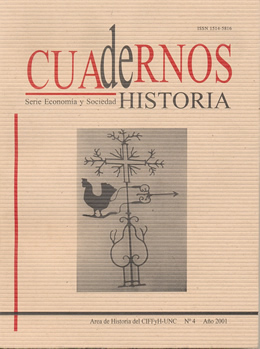Congruent support of the Cordovan parish priests. Ecclesiastical Tariffs in Cordoba in the nineteenth century
DOI:
https://doi.org/10.53872/2422.7544.n4.9879Abstract
The conflict we will deal with here, although it dates back to the beginning of the 19th century, is much older and continues a peregrine discussion started in Tucumán around 1610 and in all America around the same time. The abundance of documents that try to elucidate on the convenience or not of reforming the parochial ecclesiastical tariffs of the bishopric of Cordoba at the beginning of the XIX century, led us to question ourselves about the real importance of the subject. The collection of fees was a custom that stipulated what the parish priests should receive for the provision of certain services such as: masses, burials, marriages or baptisms. These fees, commonly called tariffs in America, were destined to support the parish clergy. In this context, we wonder whether the reform of the Tariff of 1821 was inspired by the government's desire to intervene in the business of the Church, considering it part of the state's business, or whether these changes can simply be counted among the many changes made by the local government in order to order the life and economy of the province. Thinking that the discussion on the tariff shows, or highlights other general questions that were being posed to the new Cordovan state, we are concerned to know: 1) if the variation of the tariffs was really important with respect to those in force before 1821, 2) to what extent these modifications affected the annual fees of the parish priests and 3) if they were part of a larger program aimed at changing the Church-State-Society relationship or if they are simply another indicator of the moment of political change that the "United" Provinces were going through. Without neglecting the institutional political framework surrounding the problem, we will work focusing mainly on the underlying reasons for the discussion unleashed by the Tariff Reform of 1821. We believe that the problems arising from this cause are linked, on the one hand, to certain claims about the decrease in the income of the parish priests. On the other hand, we believe that the protests of the priests are related to the break that the reform of the tariff produced in the image that the priests had of themselves, an image that was returned to them by the "mirror of society".
References
Acevedo, Edberto O., 1986, “Los Aranceles eclesiásticos Altoperuanos”, Revista chilena de Historia del Derecho. nº 12, Santiago de Chile.
Acevedo, Edberto O., 1986 (b) “Protestas indígenas contra aranceles eclesiásticos” Historia, 21, pp. 9-30.
Arancibia J. M. - Dellaferrera N., 1979, Los sínodos del antiguo Tucumán. Editorial Teología, Córdoba.
Arcondo, Aníbal, 1993, El ocaso de una sociedad estamental. Córdoba entre 1700-1760. Córdoba, Editorial de la UNC.
Ayrolo, Valentina, 2000 “Representaciones sociales de los eclesiásticos cordobeses de principios del siglo XIX” Revista Andes, Universidad Nacional de Salta, nº 11.
Ayrolo, Valentina, 2001, “Cura de almas. Aproximación al clero secular de la diócesis de Córdoba del Tucumán, en la primera mitad del siglo XIX” en Anuario del IHES, nº 16, Tandil, en prensa.
Berger, P. - Luckmann, T. (1968) 1995, La construcción social de la realidad Editorial Amorrortu, Buenos Aires.
Bruno, Cayetano, 1993, La Iglesia en Argentina. Cuatrocientos años de historia. Editorial del Centro de Estudios Salesianos, Estudios Proyecto nº 10, Buenos Aires.
Caretta, Gabriela A., 1999, “Con el poder de las palabras y de los hechos: el clero colonial de Salta entre 1770-1820” en Persistencias y cambios: Salta y el Noroeste argentino, 1770-1840. Rosario, prohistoria & manuel súarez-editor.
Chiaramonte, José Carlos, 1999, “Ciudadanía, soberanía y representación en la génesis del estado argentino (C.1810-1852)” en Ciudadanía política y formación de las naciones. FCE, México.
Concolorcorvo (1942) 1997, El lazarillo de ciegos caminantes. Editorial Emecé, Buenos Aires.
Elias, Norbert, 1985, La société de Cour. Editorial Champs-Flamarion, Paris.
García Jordán Pilar, 1988, Iglesia y poder en el Perú contemporáneo 1821-1919. Lima, Centro de Estudios Andinos “Bartolomé de las Casas”.
Halperin Donghi Tulio, 1985, Tradición política española e ideología de revolucionaria de Mayo. CEAL, Buenos Aires.
Martínez de Sánchez, Ana María, 1997, “El arancel eclesiástico en el obispado del Tucumán” en: Revista de Historia del Derecho, nº 25, Instituto de Investigaciones de Historia del Derecho, Buenos Aires, pp. 391-410.
Martínez Paz Enrique, 1941, La formación histórica de la Provincia de Córdoba. Córdoba, Editorial de la UNC.
Punta, Ana Inés, 1997, Córdoba Borbónica. Editorial de la UNC, Córdoba. Sarmiento, Domingo F., 1997, Facundo. Losada, Buenos Aires
Taylor, William B., 1999, Ministros de lo sagrado. Sacerdotes y feligreses en el México del siglo XVIII. México, El colegio de México y El colegio de Michoacán, 2 tomos.
Tejeda, Manuel Teruel Gregorio de, 1993, Vocabulario básico de la Iglesia. Editorial, Crítica Barcelona.
Zuretti, Juan Carlos, 1972, Nueva Historia Eclesiástica argentina. Editorial, Itinerarium, Buenos Aires.
Downloads
Published
Issue
Section
License
Copyright (c) 2014 Cuadernos de historia. Serie Economía y Sociedad

This work is licensed under a Creative Commons Attribution 4.0 International License.
Authors publishing in this journal accept the following terms:
a. The author maintains their copyrights and grants this journal the publication of the first original version of their work that is subject to the Creative Commons Attribution License 4.0. This license agreement allows:
Sharing — copy and redistribution of the published material by any means and formats
Reusing — remix, change, and creation of new material from the published work for any purpose, including commercial use.
b. Authors may enter other non-exclusive license agreements of distribution of the version of the published work (i.e. uploading the material on an institutional virtual archive or republishing it on a monographic volume) as long as they attribute the publication of the original version to this journal.
c. It is allowed and recommended that authors publicize their work on the Internet (i.e. on institutional virtual archives or on their personal or professional websites) after their work has been published in this journal.




